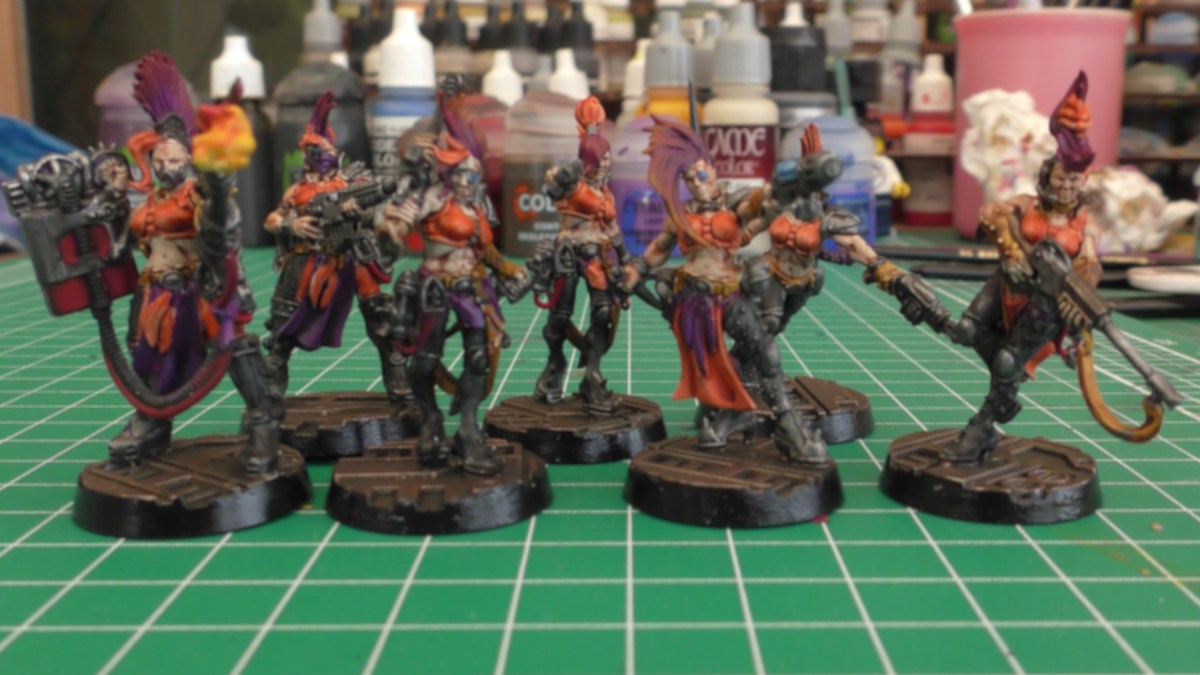Use your cards strategically to make your opponents discard cards, or to protect your own. The card’s “aura” reveals what color you’re playing, but not the value.
At a glance: Aura is a game by Michael Orion for 2 to 4 players, ages 8 and up, and takes 20–40 minutes to play. It retails for $25 and is currently available in stores and directly from Breaking Games. The game has an abstract theme so there’s nothing inappropriate for younger players, so I think the age rating is good.
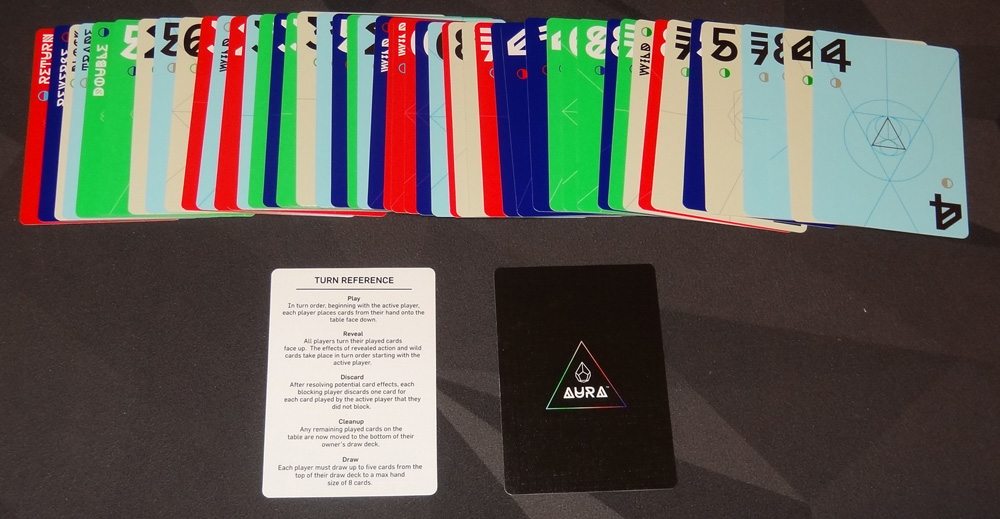
Components
Aura contains 4 deck boxes, each with a 52-card deck:
- 40 Numbered cards (1–8 in five colors)
- 5 Wild cards (1 in each color)
- 5 Action cards (1 in each color)
- 1 Aura card (black)
- 1 Reference card
Okay, I do have some nits to pick about the components, but do stay tuned for the gameplay section.
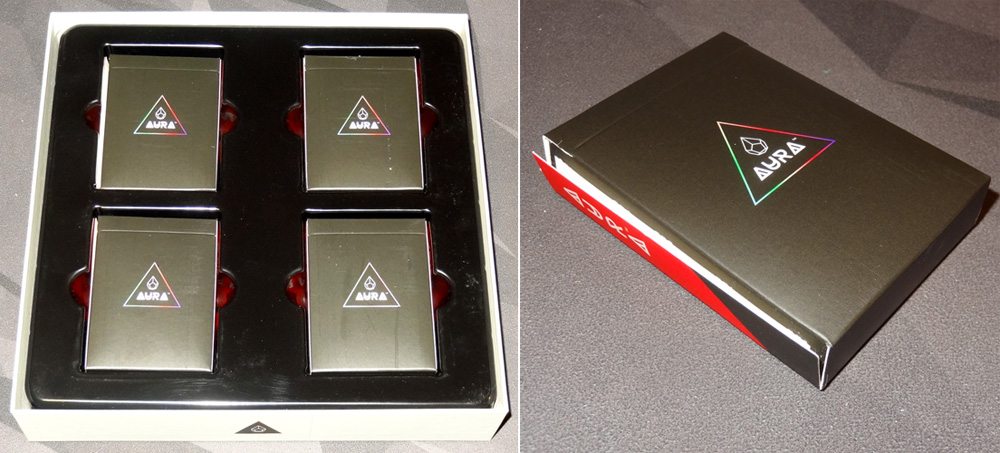
The game box itself is a large square box, a similar size to many other games you may have on your shelf, but inside are tuckboxes in an insert, plus the rulebook (which is the size of the box). While I understand there are various reasons for this, including shelf space and standard box sizes and all of that, it’s kind of frustrating to have such a large box for what is basically four decks of cards. But if you ditch the big box, then you have a big rulebook that doesn’t fit anywhere. It would have been nice to have a small format rulebook, maybe something the size of the tuckboxes, so that you could ditch the outer box when you take the game somewhere.
The tuckboxes themselves are okay, but as you can see above, one of my boxes is already coming unglued after just a few plays. The tuckboxes were also individually shrink-wrapped for some reason, and a couple of them in particular had part of the plastic glued to the side of the box, so those boxes are now sticky on the side.

The other thing I found really odd was that, despite the fact that the game consists of four player decks and all of the cards come in the tuckboxes, the cards aren’t collated. Before the first time you play, you will have to take all the cards out of all four boxes, and then sort them out into the four decks according to the card backs, which have a different number of lines, as shown above. Granted, this is only something you have to do the first time you play, but it seemed really strange to me that they didn’t come collated to begin with. Even if you were planning to play with just two players the first time, you still have to open all four boxes.
One last note: the card game is all about colors, so it’s not necessarily color-blind-friendly. I don’t know if the contrast on the various colors is enough to tell them apart, but there are no additional marks or icons to distinguish two cards of the same value. In addition, each color has another color that trumps it, shown by the color of the stripes and the icon on the back of the card (and a little circle on the front). The problem is, these colors don’t quite match up with the pentagon on the reference card, or in some cases with the card itself. The reference card shows purple, but the cards themselves look more like a dark blue. The light color is beige on the cards, but grey when it’s printed on something. For a game that is so dependent on the colors, it’s a shame that things don’t match up quite so well.
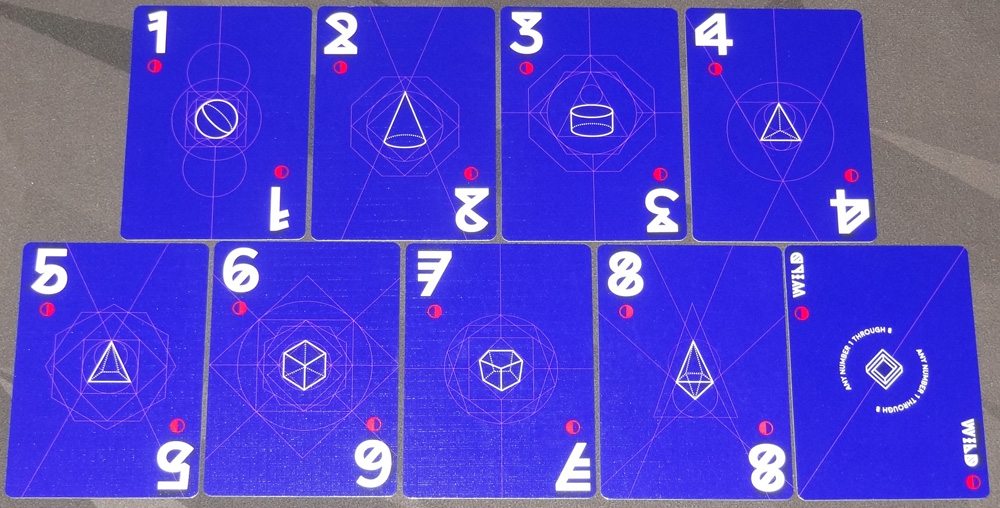
How to Play
You can download a copy of the rulebook here.
The goal of the game is to have the most cards in your deck by the end of the game.
To set up, each player takes one deck of cards. Set aside the black Aura card and shuffle the rest. The first time you play, you may also want to remove the 5 action cards (one of each color). Place the Aura card at the bottom of your deck, and then draw a hand of 8 cards.
Players will take turns as the active player; the active player will attack, and the other players will defend.
To play an attack, place 2 to 5 cards from your hand face-down in a row on the table. The cards must be all the same color, or all different colors.

The other players may then try to block the attack. Each defender plays independently of the others. Place one card in front of each of the active player’s cards that you wish to block—you may play up to one block per attack card, or none at all. Defenders do not have any color restrictions on what they may play.
Once everyone is done playing cards, all of the cards are revealed. To block an attack, you must have either a higher value of the same color, or any value of the trump color. However, if the attack includes any multiples of the same value, then those cards form a chain. If you fail to block any card in a chain, then the entire chain is not blocked.
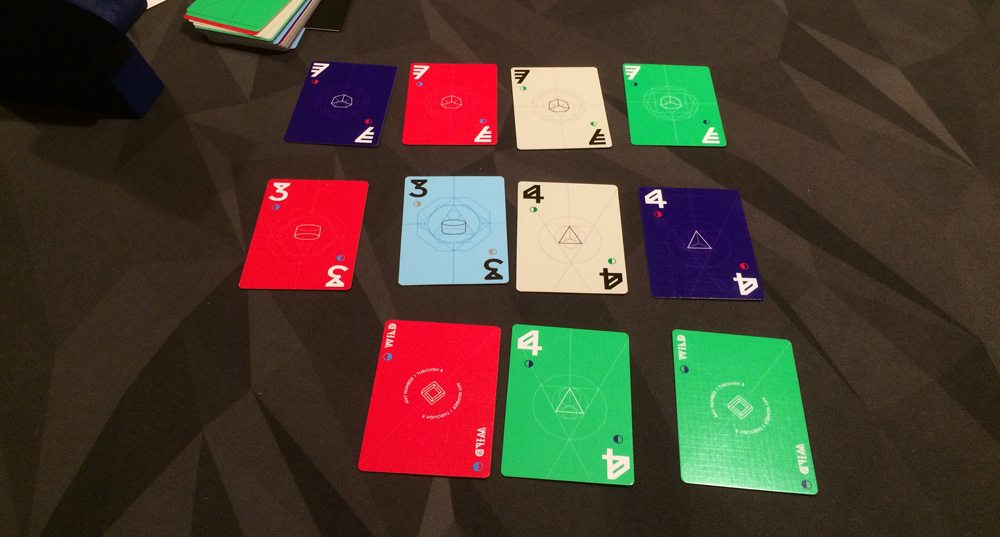
For each card that is not blocked, you must discard one card either from your hand or from the top of your deck. Discarded cards are out of the game. Then, all players put their played cards from this round at the bottom of their own decks.
If any player blocked all of the attack, the active player may play one additional attack. This bonus attack may only happen once per turn, even if the bonus attack is completely blocked.
Finally, at the end of the round, each player draws cards from their own deck—you may draw as many as 5 cards, but up to a maximum hand size of 8. The next player becomes active player.
If your Aura card reaches the top of your deck, set it aside, shuffle the deck, and then put the Aura back at the bottom. The game will end at the end of the turn when anyone’s Aura is revealed for the second time.
Whoever has the most cards left in their draw deck and hand is the winner. In case of a tie, the player with the fewest action cards and wild cards in their discard pile wins. If there’s still a tie, the player with the lowest total value of discarded cards wins—but hope you don’t get to that point, because that’s a bunch of addition.

Once you’re ready, you can throw in the action cards. Each color has its own action. Action cards are considered the highest value for the color, so they can be used to block even an 8 or a wild.
Once all cards are revealed, each player in turn order (starting with the active player) resolves action cards that they have played (in the order of their choice).
- Return: You may put any card in play back in its owner’s hand.
- Double: Defenders must discard double the cards while this is revealed.
- Trade: You may trade this card with any card from your discard pile, putting it into play.
- Reverse: Any attacks that were blocked are unblocked, and vice versa. Two Reverse cards cancel each other.
- Block: You block all of the active player’s attacks. (This can be Reversed, so that you block none of the attacks.)
The Verdict
Despite my complaints about the components, I really enjoyed the gameplay of Aura. It’s an abstract game and doesn’t have a clear theme, but it can really get you thinking, both when you’re the active player and when you’re defending.
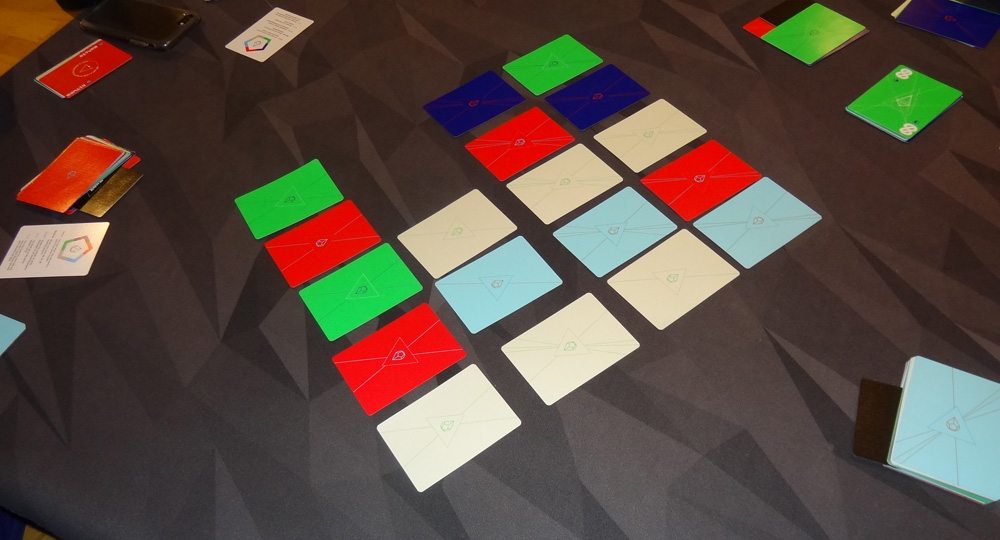
Attacking with different colors can be more powerful because of the chains—if you can play five cards of the same number (or wilds), then the defender must block all of them, or else lose five cards. On the other hand, when you play several cards of the same color, the opponents know there’s at most a pair (if you have a wild card) but they don’t know which ones are higher values and which are lower values. Also, it’s less likely for players to have five of the same color as you, which means some of your attacks may get through even without the chains.
There’s always the option to play trump colors instead of trying to beat the values, but only if you have enough of the right colors. Since you can always look around to see what colors other players have in their hands before you play your attack, you can often customize your attack to prevent somebody from trumping all of your attacks.

When it’s your turn to defend, you often have to make some tough choices. If you suspect that somebody has played a chain, is it worth it to try defending (in case it’s not a chain) or should you just save cards in your hand instead? Do you use your trump cards to guarantee a block, or save them for an attack later?
There’s even a decision to be made when you have to discard cards: from your hand, or from the top of your deck. Discarding from your hand lets you control what you’re throwing away, but if your hand is full of good cards, maybe you want to hang onto them. Discarding from your deck, though, can be dangerous—oops, there goes a wild. There goes a 7.
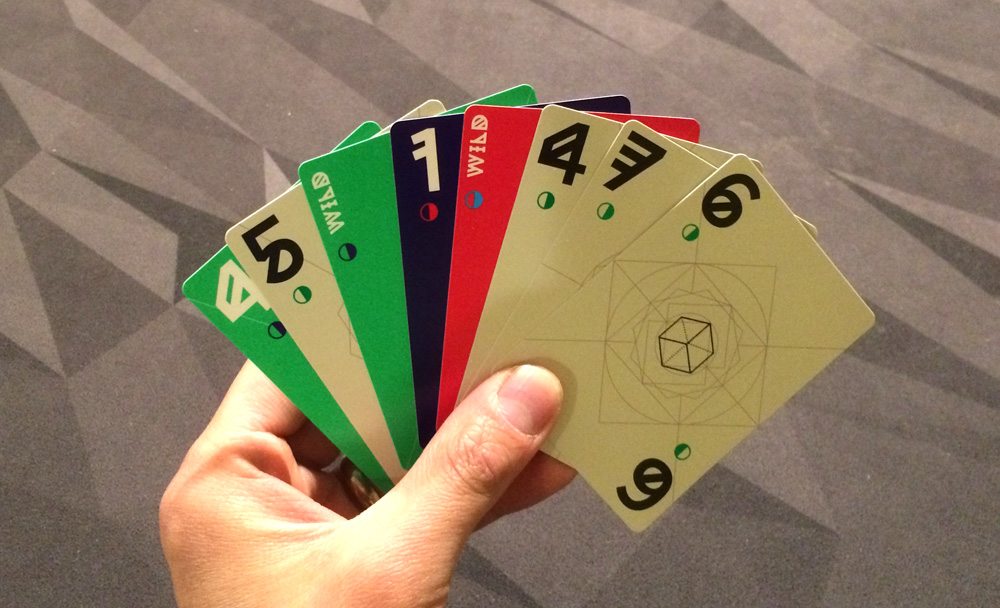
Once you throw in the action cards, though, things get really interesting. Since each action card only comes in one color, you can tell what is potentially being played. Is the active player’s red card a Return? If so, I might lose one of my blocking cards. What about that green card—will I have to discard twice as many cards if an attack gets through? Sometimes it may be worth using an action card as defense, since it beats all numerical values—but there can be dangerous consequences, too, particularly if the Reverse is in play and you weren’t expecting it. With the action cards, the game isn’t just a numbers game, and it becomes even more important to try to figure out what your opponents are up to.
Aura seems pretty simple at first, but it has some depth to it and it’s a lot of fun if you enjoy out-thinking opponents (or trying to). I have my complaints about the components, but not about the mechanics. I’d recommend it for people who like abstract games, since there isn’t a strong thematic element to it.
Click here for a full index of our tabletop game reviews.
Disclosure: I received a review copy of this game.





